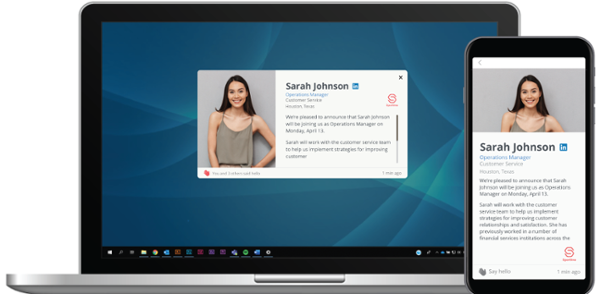
It’s day one in a new job. Exciting times ahead, right? Perhaps not. Nearly three-quarters (74%) of US employees are actively looking or open to new opportunities in the next 6-12 months (Source: Lattice).
A good onboarding program is an important part of the solution, but internal communications are the rocket fuel that makes it mighty. It increases onboarding effectiveness by informing, engaging, and inspiring new staff.
These five tips for using internal communications to improve your HR process for new hires are sure to get your superstars of tomorrow off to a flying start.
1. Bring the company to life
Your company is so much more than an org chart and a fancy logo. It’s a hive of innovation, driven by vibrant personalities and big ideas. Not showcasing these to new employees is a wasted opportunity.
Swap your text-heavy company history and floor plans for a video tour of where the company has come from and where it’s headed. Include brief features on key employees, especially your owner or CEO – even if they’re reluctant!
If your new hires are based in remote offices or work in a virtual team, share the tour with them through video alerts so that they aren’t neglected.
At our company, we have personal bios written for every new staff member. New hires have their face and story displayed prominently to alleviate any awkward introductions, while they can read the bios of everyone else online to find ‘buddies’ with whom they can make a connection.
2. Establish the source of truth
If they’re lucky enough to join a friendly, helpful workplace, new hires may find themselves overwhelmed by well-intentioned advice. This desire to help someone else is one of humankind’s most laudable traits, but because of its personal nature, that help can sometimes actually be a hindrance.
It’s immensely helpful to establish one place as the single source of truth. Your corporate intranet is the most appropriate channel to use for this, given its flexibility, ease of access, and simplicity of updating. However, a dedicated file directory on your local network could also suffice.
Whichever you use, make sure this is *the* place to go for official paperwork, employee benefits, staff contact lists, department seating plans, location of key amenities, and so on.
3. Speak the way staff want to listen
Every new hire brings with them preferences and expectations from their personal lives. Near the top of this list will be communication styles and formats. Short snippets of highly-visual information, delivered in interactive channels, are favored these days – particularly for younger staff.
Consider this ‘consumer-grade’ when crafting your onboarding program. Review the language you use – is it too officious or dry? Does it make the company feel cold or standoffish?
Incorporate communication formats that are more visually compelling and dynamic. Look beyond traditional emails to more contemporary channels like video alerts or digital newsletters.
Employment expert Gareth Flynn, Managing Director of The Career Conversation, believes, “Onboarding is an opportunity to engage soon-to-be and new hires via media-rich content, quizzes, information about the business, their team, etc. We are moving into a world where participant experience is a key market differentiator and a key pillar of a company’s employment brand."
4. Build internal brand
When it comes to knowledge of your brand, chances are your new hire may not know much more than what the company offers or produces. They’re unlikely to know your overarching vision, what values you stand for and what sets you apart from competitors.
Instilling this into new hires early is essential, both for them to know what’s expected and to properly feel integrated into the wider company.
The natural first step is to emblazon your internal branding across channels like your intranet. But use internal comms to do the heavy lifting when it comes to promotion. Corporate screensavers and similar passive tools are highly effective at reminding staff and reinforcing the brand. Messaging is seen so repeatedly that learning is virtually subliminal!
5. Encourage contributions
Starting a new job can be a challenging experience, but it’s also a fantastic opportunity for fresh thinking. New employees are unencumbered by ingrained modes of thinking. Their minds are open. For HR managers, this is a chance to capture lightning in a jar.
Encourage new staff to provide feedback on the onboarding process. How useful was it? What do they feel was missing? What do they wish they knew on day 1… day 30… or even day 90?
Once they’re settled, contact new staff to solicit their thoughts. This could be through an employee survey to collect specific information, or via an online forum to encourage open discussion. Use the insights gained to improve the process for all subsequent new arrivals.
Internal communication can lift the effectiveness of your onboarding process by smoothing the period of transition and helping new hires become high-performing employees faster.
Read the full article at HR News.

